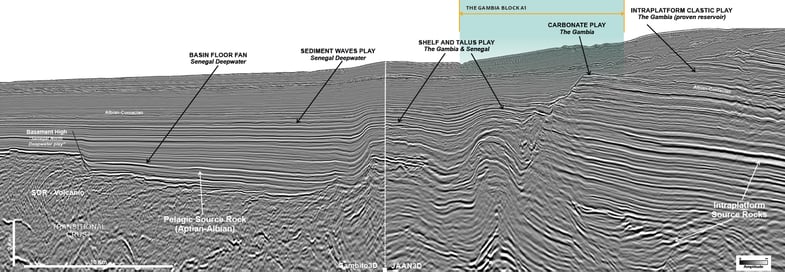First Published: GEO ExPro, Issue 2 , April 2022Felicia Winter1*, Anongporn Intawong, and Paolo Esestime analyze the flurry of activity that continues in The Gambia and Senegal, and use TGS seismic to connect the shelf to the deepwater.
In 2020 and 2021, TGS acquired and processed more than 4,000 km2 of broadband 3D seismic offshore The Gambia and in deepwater Senegal, adding to an extensive 3D and 2D seismic library and complemented by a regional multibeam survey and seabed coring samples. TGS data enables the hunt for new exploration opportunities, leading to the generation of untested prospects and extending the discovery trends identified by the FAN and SNE wells. The knowledge gained from the latest exploration can be combined seamlessly with historical phases through the entire Mauritania, Senegal, Guinea-Bissau, and Republic of Guinea Conakry regions (MSGBC).
North West Africa has revealed world-class petroleum systems with a variety of targets and trapping mechanisms. The Sangomar field development has proven their commerciality and added over 330 MMbbls of oil reserves to the world-class gas discoveries of Tortue, Takaar and Orca-1. The Gambia bidding round of Block A1 is the latest opportunity to chase these prolific plays into newly released acreage, and additionally, the blocks available in deepwater Senegal allow extension of those plays into the outboard area.
TGS Seismic (in partnership with Geo Partners) covers Gambia Block A1 and provides a regional perspective.
The Gambia, Bid Opportunity Prospects
Block A1 is now open to exploration, with several untested prospects, combining mixed structural-stratigraphic closures. The hydrocarbon charge is provided by two different source rock systems: within the carbonate platform and in the pelagic environment (Foldout and Figure 1 in PDF). The pelagic shales are easily recognized by seismic character and are widely distributed throughout the deepwater areas, over transitional, and onto the neighboring oceanic crust, allowing oil maturity at multiple burial depths due to different thermal regimes. The intraplatform source rocks are deeply buried underneath the Cretaceous shallow-water limestones. Migration pathways converge at the uplifted crests along the palaeo-shelf edge of the landward dipping shelf, where most of the structural and stratigraphic closures present themselves. Porous, karstified limestones and coarse-grained clastics present reasonable trap sizes and reservoir properties, as highlighted by their geophysical responses, and can be associated with viable target volumes. The good quality of intra-platform clastic reservoirs has been proven by wells Bambo-1, Samo-1, and Jammah-1, offshore The Gambia, and future successes are expected in mixed stratigraphic-structural prospects – analogous to those in the discoveries of the SNE and FAN wells...
<continued>
Download the full article using the link at the top of this page.

